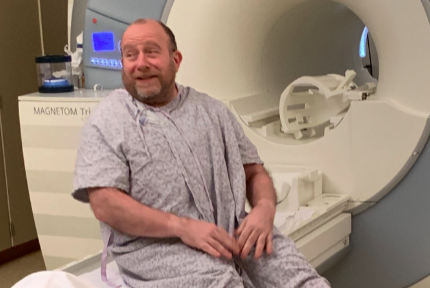From the perspective of the pandemic, reporter Phil Gutis reflects on a visit to an assisted living and memory care facility in Princeton, New Jersey.
Last September, long before COVID-19, quarantines and national lockdowns, I visited a memory care facility in Princeton, New Jersey. A friend worked there and had invited me for a tour. After a lot of thought, I agreed to enter a memory care facility for the first time.
I’m still in the beginning stages of my Alzheimer’s journey, so I wasn’t touring the home to see if I wanted to move in. Instead I was there with my journalist’s cap on, to see for myself how such facilities operate. If I’m being honest, though, I also wanted to try to put to rest a persistent fear about long-term care that I’ve quietly harbored since being diagnosed with early-onset Alzheimer’s four years ago.
I remember a gorgeous day. I was a few minutes late but I sat in the parking lot for a bit, telling myself not to be afraid. I remember thinking that if the experience were too upsetting, I — unlike the home’s residents — could just leave. I finally forced myself from my car and pushed open the door to the facility, Artis Senior Living in Princeton Junction.
I’ve thought of that visit a great deal recently as we’ve watched COVID-19 rip through long-term care facilities. The stories about dead bodies piling up, the pictures of desperate family members waving to loved ones from outside windows. The unending reporting about the loneliness of residents and the grief of family members who may never again hold their loved ones’ hands.
After all, the pandemic largely began in the United States at a nursing care facility near Seattle. And while the devastation long ago went national, long-term care facilities are still at the forefront of the suffering. Just today, the Washington Post published a piece about coronavirus outbreaks in nursing homes in Maryland.
A recent New York Times story told about the toll in the region hit hardest by COVID-19: “The virus has perhaps been cruelest at nursing homes and other facilities for older people, where a combination of factors — an aging or frail population, chronic understaffing, shortages of protective gear and constant physical contact between workers and residents — has hastened its spread.”
Last fall, there was no sign of the impending crisis. Inside the home, I found a sunny, if somewhat institutional, lobby. I met my friend and talked for a few minutes about the home, admiring its soothing decor. All was very clean and open, the staff seemed very nice and welcoming.
And then our tour began. We pushed through the locked door into the heart of the two-story home, which is divided into four “communities,” each with separate dining rooms and shared living rooms and other common areas. As we walked, my friend greeted many of the residents by name, asking about their health and chatting with each for a few minutes.
We came across a room temporarily serving as the “salon” where every week or so visiting hairdressers would offer their services. And we walked around the outside gardens that residents had access to. Yes the gardens were surrounded by tall walls, but they were still pleasant places to sit and walk. We spoke with one resident, a former professor at Princeton University, who was enjoying the sunny afternoon on a bench with a visiting friend.
And while we did encounter one woman who was obviously upset — asking us repeatedly for directions on how she could get back to her house which she believed was somewhere near Philadelphia — most everyone was smiling and or resting as we walked by. The rooms themselves were small but nice with residents allowed to decorate any way they and their families wanted.
Overall, the facility was far removed from what I remembered of nursing homes that my grandparents lived in toward the end of their lives. Those I recall to be much more hospital-like and little more than places people went to die.
I think most people still see nursing homes, assisted-living facilities and memory-care homes as just that: places people go to die. For people with that mindset, the residents of those facilities are expendable, having enjoyed life for 70, 80, 90 years, their lives already almost over.
That’s why politicians like Dan Patrick, the lieutenant governor of Texas, can get away with insisting that “there are more important things than living.”
“I don’t want to die,” Patrick recently said on Fox News. “Nobody wants to die but man we gotta take some risks and get back in the game and get this country back up and running.”
I wonder how Patrick would feel if he were in an assisted living facility, isolated from his family and afraid. Would he be so callous about his life or those of the staff who come to work each day at great personal risk? Has he spent much time with people who live and work in nursing homes or memory-care facilities?
During my brief visit to that memory-care facility in Princeton, I did not see people waiting to die. I saw men and women trying to enjoy each and every day. Talking with friends, having their hair done in a salon, eating meals amid quiet chatter.
As I drove home that afternoon, I remember feeling relieved that my worst nightmares about memory-care were unwarranted. Even if I were to reach a stage of Alzheimer’s where my family could no longer care for me, I felt better knowing that there were caring places for me to go to live.
I’m certain that life in that memory-care home in Princeton is no longer so pleasant. Outside visitors are banned (except in end-of-life situations). Outside trips and entertainment are on hold. Meal time for residents is staggered because it can be challenging (if not possible) to persuade people living with dementia to follow social distancing rules.
No one knows where the coronavirus will take us or what, exactly, our society will look like if a vaccine is found. Will long-term care facilities like nursing and memory-care homes continue to evolve toward more pleasant places, or will they slip back to the warehouse facilities I remember from my younger days?
Will this virus help us to remember and cherish our humanity, or will we be so driven by economic factors that we will be desensitized to the inherent value our seniors and other differently abled individuals hold? As I face the degenerative disease that is Alzheimer’s, I desperately hope for empathy but fear that we are being pushed toward less compassion. I hope I’m wrong.
Phil Gutis is a former New York Times reporter and current Being Patient senior reporter who was diagnosed with early onset Alzheimer’s. This article is part of the PHIL’S JOURNAL series, in which Phil chronicles his experience living with Alzheimer’s.





